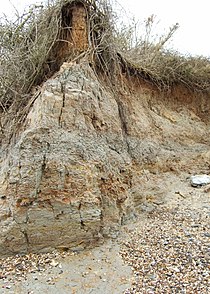London Clay
| London Clay Formation | |
|---|---|
Ma[1] | |
Formation | |
| Unit of | Thames Group |
| Underlies | Bagshot Formation (London Basin), Wittering Formation and Poole Formation (Hampshire Basin and English Channel) |
| Overlies | Harwich Formation |
| Thickness | up to 150 m |
| Location | |
| Region | southern England |
 Geological map of the London Basin; the London Clay is marked in dark brown. | |


The London Clay Formation is a
The London Clay is a stiff bluish
Large septarian concretions, produced by microbial activity (oxidation of organic matter) in the ancient seafloor during clay early diagenesis, are also common. These have been used in the past for making cement. They were once dug for this purpose at Sheppey, near Sittingbourne, and at Harwich, and also dredged, off the Hampshire coast. The clay is still used commercially for making bricks, tiles, and coarse pottery in places such as Michelmersh in Hampshire.
Distribution and geology
The London Clay is well developed in the
The clay was deposited in a sea up to 200 metres (660 ft) deep at the eastern end. Up to five cycles of deposition (representing
Claygate Beds
The youngest part of the London Clay, known as the Claygate Beds or Claygate Member forms a transition between the clay and the sandier
Engineering
The presence of a thick layer of London Clay underneath London itself, providing a soft yet stable environment for tunnelling, was instrumental in the early development of the London Underground, although this is also the reason why London had no true skyscraper buildings, at least to the same degree as many other cities throughout the world. Erecting tall buildings in London required very deep, large and costly piled foundations. This has changed in recent decades due to the development of 'plunge piles'. London's skyscrapers float on rafts embedded in the clay.
London Clay is highly susceptible to volumetric changes depending upon its moisture content.[5] During exceptionally dry periods or where the moisture is extracted by tree root activity, the clay can become desiccated and shrink in volume, and conversely swell again when the moisture content is restored. This can lead to many problems near the ground surface, including structural movement and fracturing of buildings, fractured sewers and service pipes/ducts and uneven and damaged road surfaces and pavings. Such damage is recognised to be covered by the interpretation of subsidence in buildings insurance policies, and the periods of dry weather in 1976/77 and 1988/92, in particular, led to a host of insurance claims. As a result, many insurance companies have now increased the cost of premiums for buildings located in the most susceptible areas where damage occurred, where the clay is close to the surface.
London Clay is also used to line exhausted quarries. This is because old quarry holes are generally refilled with waste material and by lining it with London Clay (which is virtually impermeable) it prevents waste and hazardous substances from entering the groundwater.
Tunnels in London Clay
London Clay is an ideal medium for boring tunnels, which is one reason why the
Uses
Due to its impermeability especially when exposed by ploughing, London Clay does not make good agricultural soil.[citation needed] In Middlesex, ploughing London Clay land so deep that it brings up clay has historically been called "ploughing up poison".[6]
It was also disliked for building houses on, though inevitably most of Greater London is built on it. Jane Ellen Panton in her Suburban Residences and How To Circumvent Them (1896),[7] remarks: "I do not believe clay is or even can be fit for anyone to reside upon ... though roses flourished magnificently children didn't, and coughs and colds [lasted through autumn and winter, this at Shortlands".[8]
Many London buildings have ultimately been constructed with London Clay. When compressed and burnt, London Clay can be fashioned into brick known as London stock, identifiable by its yellowish brown hue.[9]
Fossil flora and fauna
Plant fossils, especially seeds and fruits, are found in abundance and have been collected from the London Clay for almost 300 years. being frequently encountered.
Notable coastal exposures from which fossils can be collected are on the Isle of Sheppey in Kent and Walton-on-the-Naze, Essex, in the London Basin, and Bognor Regis in the Hampshire Basin.
Fruit and seed fossils from the Isle of Sheppey
-
Avicennia sp. fruit, Acanthaceae
-
Iodes sp. seed, Icacinaceae
-
Seed capsules of the genus Euphorbia, Euphorbiaceae
See also
- Geology of Hampshire
- Geology of Hertfordshire
- Geology of London
- Geology of the United Kingdom
- List of fossil sites
References
- ^ ISSN 0305-8719.
- ^ ISBN 0-11-884522-5.
- ISBN 0-11-884203-X.
- ISBN 0-85272-478-0.
- ^ Buildings on Clay The effects of geology, climate and vegetation on heave and settlement, Derek Clarke and Joel Smethurst
- ^ View of the Agriculture of Middlesex: With Observations on the Means of Its Improvement, and Several Essays on Agriculture in General. By Board of Agriculture (Great Britain), John Middleton. Published by G. and W. Nicol, second edition, 1807, p. 20.
- ISBN 978-1-108-05320-4.
- ISBN 0670801755
- ISBN 0099422581.
- ^ Chandler, M. E. J. 1961. The lower Tertiary floras of southern England I. Palaeocene floras, London Clay flora. London: British Museum (Natural History).
- ^ Collinson, M. (1983). Fossil plants of the London Clay. The Palaeontological Association.






